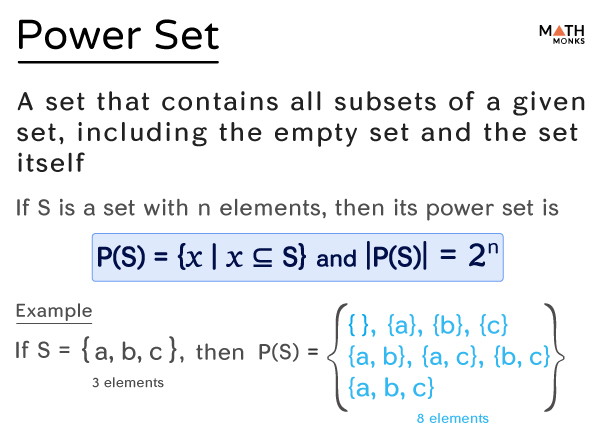In set theory, a power set is a set that contains all subsets of a given set, including the empty set and the set itself. Thus, a power set is also called a set of subjects, containing more elements than the original sets.
Symbol
If S is a set, then the power set of set S is denoted by the notation P(S) or ${\mathcal{P}(S)}$ and expressed as:
P(S) = {x | x ⊆ S}
Example
Let S = {a, b, c} be a given set.
Listing down the subsets of set S, we get:
{ }, {a}, {b}, {c}, {a, b}, {a, c}, {b, c}, {a, b, c}
Thus, the power set of S; P(S) = {{ }, {a}, {b}, {c}, {a, b}, {a, c}, {b, c}, {a, b, c}}
Cardinality
If a set has ‘n’ elements, the total number of subsets for the set is given by 2n. Since a power set has all the subsets of the set, the cardinality of the power set is written by the notation:
|P(A)| = 2n, where n = the cardinality of the given set.
Again, considering the set S = {a, b, c}
Here, n = the cardinality of set S = |S| = 3
Thus, |P(S)| = 2n = 23 = 8.
Now, let us verify by listing down all the subsets of set S.
We already obtain P(s) = {{ }, {a}, {b}, {c}, {a, b}, {a, c}, {b, c}, {a, b, c}}, which has 8 subsets.
Thus, |P(A)| = 8, verified.
Proof
We use mathematical induction to prove the cardinality of a power set.
Base Step
Let us consider an empty set S; S = ɸ = { }
Here, the power set of S, P(S) = {ɸ}
Also, the cardinality of the power set S = |P(S)| = 1 = 20
Inductive Step
Let S be a set with n number of elements, S = {x1, x2, …, xn}, and |P(S)| = 2n
Now, considering another set T = {x1, x2, …, xn, xn + 1}
The cardinality of the two sets S and T are |S| = n and |T| = n + 1
Now, T = A ∪ {an + 1}
Here, we conclude that every subset of set S is also a subset of set T, which means a subset of set T may or may not contain the element an+1
If the subset of set T does not contain the element an + 1, it is an element of set S.
Also, if the subset of T contains the element an + 1, then the element an + 1 is included in any of the 2n subsets of set S. Here, we conclude that set T has 2n subsets with the element an + 1
Thus, set T has 2n + 1 subsets with element an + 1 and 2n subsets without the element an + 1
Hence, the cardinality of the power set is proved.
Power Set of Empty Set
An empty or null set has zero elements. It contains only the set itself as its subset. Thus, the power set of an empty set ɸ = { } has 20 = 1 element.
P(ɸ) = {ɸ} = {{ }}
Power Set of Finite Set
The power set of a finite set is countable; thus, it is a finite set.
For example,
In A = {a, b, c}, the power sets are countable.
Power Set of Infinite Set
An infinite set has an infinite number of elements. Thus, the power set of an infinite set has infinite subsets.
For example,
A set of integers has an infinite number of elements. In this case, the power set contains an infinite number of subsets.
Solved Examples
![]() If D = {5, 9, 13, 17}, find the power set and its cardinality.
If D = {5, 9, 13, 17}, find the power set and its cardinality.
Solution:
![]()
Given, D = {5, 9, 13, 17}, which has 4 elements.
Here, the cardinality of the P(D) = 24 = 16
The subsets of set D are ɸ, {5}, {9}, {13}, {17}, {5, 9}, {5, 13}, {5, 17}, {9, 13}, {9, 17}, {13, 17}, {5, 9, 13}, {5, 9, 17}, {5, 13, 17}, {9, 13, 17}, {5, 9, 13, 17}
Thus, the power set D = {ɸ, {5}, {9}, {13}, {17}, {5, 9}, {5, 13}, {5, 17}, {9, 13}, {9, 17}, {13, 17}, {5, 9, 13}, {5, 9, 17}, {5, 13, 17}, {9, 13, 17}, {5, 9, 13, 17}} and its cardinality is |P(D)| = 16
![]() If A = {9, 8, 7, 6, u, v, w, x, y}, how many elements will its power set have?
If A = {9, 8, 7, 6, u, v, w, x, y}, how many elements will its power set have?
Solution:
![]()
Given set A = {9, 8, 7, 6, u, v, w, x, y}, which has 9 elements.
Thus, its power set has 29 = 512 elements.
![]() Determine the power set of M = {Monday, Friday}
Determine the power set of M = {Monday, Friday}
Solution:
![]()
Given set M = {Monday, Friday}
The subsets of M are ɸ, {Monday}, {Friday}, {Monday, Friday}
Thus, the power set of set M is P(M) = {ɸ, {Monday}, {Friday}, {Monday, Friday}}

